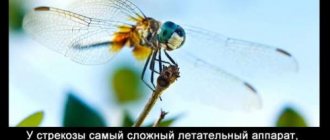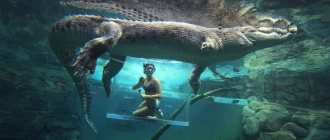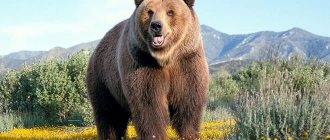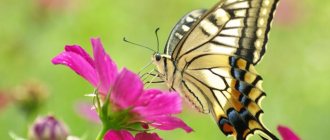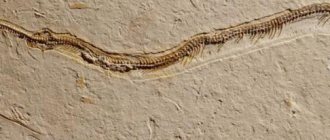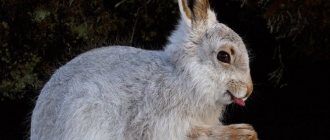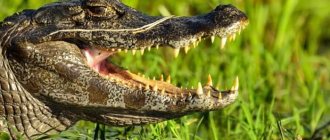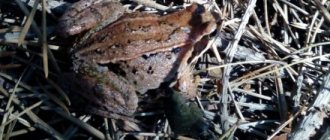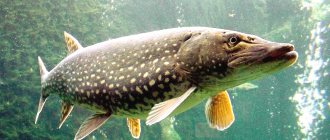Crocodiles are an extremely interesting species of semi-aquatic predators. These animals belong to the order of aquatic vertebrates and have received the status of the largest individuals of the reptile species. Historically, crocodiles are considered ancient descendants of dinosaurs, as the species dates back more than 250 million years. This species is rightfully unique, since over such a huge period of existence, its appearance has remained virtually unchanged. What is surprising is that, in terms of their internal structure, crocodiles have more in common with birds, although they are a reptile species. The name "crocodile" originates from the Greek word "crocodilos", which means "spanner worm". It is likely that in ancient times the Greeks compared the crocodile to a reptile with lumpy skin and a worm, characterized by its long body.
General characteristics of the order of true crocodiles
The order of true crocodiles includes 15 species of predators, which differ in external features and habitat. Typically, most crocodiles have a name related to their widespread range.
True crocodiles are divided into the following types:
Saltwater (or combed, saltwater) crocodile . This representative has a distinctive feature in the form of ridges in the eye area. The appearance of this species inspires fear due to its huge dimensions. This species is rightfully considered the largest and most dangerous predator among crocodiles. The body size can reach 7 meters in length. You can meet this representative in Southeast Asia and Northern Australia.
Nile crocodile . The largest species in Africa. It ranks second in size after the saltwater crocodile. The body size of this representative has always been a subject of debate. But the officially registered one reaches no more than 6 meters.
Indian (or marsh) crocodile or mager . By the standards of the entire species, the Indian crocodile is an average representative. The size of the male is 3 meters. This species is better adapted to land than others and can spend most of its time there. Populated the territory of India.
American (or sharp-snouted) crocodile . This representative can reach the size of a Nile crocodile. It is considered a dangerous reptile, but attacks people extremely rarely. It got its name “sharp-snout” due to its elongated and narrow jaws. The population of this species is found in South and North America.
African narrow-snouted crocodile . The crocodile is considered narrow-snouted due to its specific mora structure. The narrowness and slenderness of the jaws allows this species to easily cope with fishing. The species is listed in the Red Book as endangered. The last species are preserved in Gabon in Africa.
Orinoco crocodile . The largest representative of South America. It has a narrow snout, which helps to catch marine life for food. This representative suffers the most from poachers, since his skin carries a lot of weight on the black market.
Australian narrow-snouted crocodile or Johnston's crocodile . Relatively small representative. The male is 2.5 meters long. Inhabited the northern coast of Australia.
Philippine crocodile . The population of this species is found exclusively in the Philippines. The external difference lies in the wide structure of the muzzle. The Philippine crocodile is considered extremely aggressive. But since its habitat is far from human settlements, attacks are extremely rare.
Central American crocodile or Morel's crocodile . This species was discovered only in 1850 by the French naturalist Morelet, for which the crocodile received a second name. The Morel species inhabited the territory of freshwater bodies of Central America.
New Guinea crocodile . The representative is listed in the Red Book. Its habitat is located only in Indonesia. It prefers to inhabit fresh water bodies and is nocturnal.
Cuban crocodile . Settled on the islands of Cuba. A key feature of this species is its relatively long limbs, which allow it to pursue prey on land. It is considered a very aggressive and dangerous species.
Siamese crocodile . An extremely rare representative that can only be found in Cambodia. Its size does not exceed 3 meters.
African or blunt-snouted dwarf crocodile . A relatively small representative of crocodiles. Maximum body length is 1.5 meters. Populated African swamps and lakes.
Interesting Facts
Living during the time of dinosaurs, crocodiles still amaze the imagination with their monstrous appearance, habits, and incredible properties.
- Cannibalism. A hungry Nile crocodile does not stop in capturing a victim, even if it is a weaker young representative of its species. A caring mother, a female who has raised many generations, is capable of eating her offspring, who have already left her care.
- The brain of crocodiles is the most developed of all reptiles, characterized by the presence of a cortex responsible for intellectual functions.
- The main sensory organ of crocodiles are vibration receptors located in the oral cavity, on the jaws. With these receptors, the reptile senses the presence of a potential victim in the water, or any animal at a great distance.
- The closest modern relatives of crocodiles are birds, descendants of archosaurs.
- Despite their heavy weight and clumsy movement on land, reptiles can gallop when running and reach speeds of up to 20 km/h. They are also capable of jumping to considerable lengths.
- Crocodiles can "sing" - these are vibrating low sounds, similar to thunder, which they make during the courtship season.
- Female Nile reptiles sometimes make nests in the neighborhood. When the young hatch, the mothers look after the offspring together, like a “crocodile nursery.”
- Threatening predators peacefully coexist with small birds - Egyptian runners (Pluvianus aegyptius), lapwings (Vanellus spinosus), which serve as “dentists” for them. These coastal birds obtain food by cleaning the mouths of crocodiles from the remains of meat. At this time, the ominous reptile can lie for a long time with its mouth open, waiting for the completion of the “sanitation” of the teeth.
- When overheated in hot weather, the crocodile keeps its mouth open for hours to cool its body.
- Secondary aquatic reptiles are adapted to life in fresh and salt water bodies. They can spend about a month in the open ocean, covering considerable distances.
- Wounds on the body of animals heal quickly without inflammation, thanks to the antiseptic properties of their blood.
- Crocodiles are capable of training and allow their feeders to ride them.
- In the 30s of the twentieth century in the city of New York (USA), crocodiles up to 2 meters in size spread in sewer systems. When cleaning the canals, they were destroyed with poison.
- The crocodile is a totem animal among the modern aborigines of Madagascar. They perform religious ceremonies with the participation of these reptiles and sacrifice domestic animals.
General characteristics of the alligator squad
The second most common type. Includes 8 representatives. Includes the following types:
American (or Mississippi) alligator. It is considered a very large species of the alligator order. The average body length of males varies around 4 meters. Features strong jaws. Lives on the southern side of America.
Chinese alligator. A unique view in China. In size it reaches a maximum length of 2 meters. An extremely small representative. The population numbers only 200 alligators.
Black caiman. In terms of its dimensions, it shares first place with the American representative. The body length of this alligator can reach 6 meters. Popular in Latin America. Attacks on humans have been recorded.
Crocodile (or spectacled) caiman. Medium-sized representative. The body length reaches no more than 2.5 meters. Other alligators are more popular, spreading from Belize and Guatemala to Peru and Mexico.
Broad-faced caiman. Quite a large species. Its size ranges from 3 to 3.5 meters. Inhabited the territory of Argentina.
Paraguayan (or Yacar) caiman. An extremely small representative. Occupies the southern range of Brazil and northern Argentina. Less common in Paraguay and the southern side of Bolivia.
Cuvier's dwarf (or smooth-faced) caiman. The body length of this caiman does not exceed 1.6 meters, which is quite small in comparison with its relatives. It is considered the smallest representative of the entire squad. The species lives in Brazil, Paraguay, Peru, Ecuador and Guyana. The French naturalist Cuvier first discovered this species in 1807.
Schneider's smooth-faced (or dwarf) caiman. This species is slightly larger than Cuvier's caiman. Its size can reach 2.3 meters. The distribution area extends from Venezuela to southern Brazil.
Terrarium of the Moscow Zoo in Russia
Currently, you can see crocodiles in Russia only by visiting the “Terrarium” in zoos. In Moscow, it provides the opportunity to get acquainted with the following animals:
- The Mississippi alligator, which naturally lives in fresh water bodies of water in the southeastern United States;
- A Chinese alligator that is protected by law internationally.
These alligators are the only animals that hibernate during the winter. The male Mississippi alligator, Saturn, has an interesting life story. Before the outbreak of World War II, he was a resident of a zoo in Berlin and belonged to Hitler personally. After the end of the war, it came to England as a trophy, from where the country's government transferred it to Russia as a gift in 1946. So he began to live in the Moscow Zoo. The crocodile is approximately 85 - 100 years old, but this is not an exact figure.
The Moscow Zoo was open to visitors even during the war. Some animals were sent to areas of Russia where there was no military action, mainly to Sverdlovsk. Almost all predators, including reptiles, remained in place.
The real crocodiles in the Moscow Zoo are represented by the gharial crocodile, whose length reaches 5 meters. This is the largest of all the other representatives of the zoo. The blunt-snouted crocodile also lives there. This is the smallest species, its length does not exceed 1.7 m. He is very curious and poses no danger to people. One batch of these predators was delivered from Australia.
The collection of real facts from the life of crocodiles is constantly growing. Delving into mysterious stories, including those relating to the life of these amazing reptiles similar to dinosaurs, people think about the incredible world that reigns around them, and also learn a lot that is still unknown to themselves.
General characteristics of the gharial order
This representative includes only two species - the Gangetic gharial and the gharial crocodile . These species are considered large semi-aquatic reptiles similar to common crocodiles. A distinctive feature is the very thin structure of the muzzle, with the help of which they can deftly cope with catching fish.
The habitat of the gharial crocodile has spread to Indonesia, Vietnam and Malaysia.
The Gangetic gharial is sometimes found in Nepal, Myanmar and Bangladesh. In many areas this species has completely disappeared. The gharial order spends most of its time in the water, where it can reach its food with dexterity.
Nutrition of crocodiles
Most representatives prefer solitary hunting; rare species can cooperate to search for prey. The oldest crocodiles include large game in their diet. These include:
- Antelopes;
- Lions;
- Rhinoceroses and elephants;
- Hippos;
- Buffaloes;
- Zebras.
No other animal compares to the crocodile with its sharp teeth and wide mouth. Once the victim gets into the mouth of a crocodile, he will not be able to get out of it. As a rule, the crocodile swallows its prey whole, and sometimes tears it into pieces. Large crocodiles eat a huge amount of food per day, usually amounting to 23% of their own body weight.
Since ancient times, their constant product has been fish. Thanks to its habitat, this type of snack is as fast and accessible as possible.
Teeth are always white
A crocodile needs teeth to obtain and eat food. They are positioned in such a way that the victim can no longer get out of the slammed mouth. For gripping, there are four large fangs at the beginning of the jaw; teeth for cutting, they are thicker, located in the middle. The tooth at the base is wider than at the top, flatter, which makes it possible to grind strong mollusk shells and turtle shells.
An important feature of crocodile teeth is that as they wear out, they are replaced with new ones. A new tooth is formed inside the old tooth and is replaced every two years, so they are always white, like “new.”
Breeding period and offspring
Crocodiles are considered polygamous representatives of reptiles. The mating season is characterized by bloody fights between males for the attention of the chosen female. When a pair forms, the female lays her eggs in the shallows. To hide them from prying eyes, she covers the eggs with earth and grass. Some females bury them deep into the ground. The number of eggs laid depends on the species of representatives. Their number can be either 10 or 100. During the incubation period, the female does not leave her clutches, as she constantly protects them from potential danger. The timing of the appearance of crocodiles depends on climatic conditions, but, as a rule, it lasts no more than 3 months. Small crocodiles are born at the same time, and their body size barely reaches 28 centimeters. Trying to get out of the shell, newborns begin to squeak loudly to attract the mother's attention. If the mother has heard, she helps her offspring get out of their eggs with her sharp teeth, which she uses to break the shell. After successful hatching, the female takes her children to the pond.
Just a couple of days later, the mother breaks off contact with her offspring. Small crocodiles go out into the wild completely unarmed and helpless.
Not all species monitor their offspring. Most representatives of gharials leave their “nest” after laying eggs and completely leave their offspring.
Since crocodiles are forced to mature quite early, their mortality rate at an early age is quite high. Small crocodiles are forced to hide from wild predators, and at first they feed exclusively on insects. Already growing up, they can cope with hunting fish, and as adults they can hunt large game.
A little bit of history
God Sobek, who was worshiped by the inhabitants of Ancient Egypt, had the head of a crocodile and was a symbol of the power of the pharaoh. The Egyptians did not always get along with their patron and sometimes allowed themselves to hunt local crocodiles. They also used spells to avoid angering these reptiles. According to the Egyptians, West African crocodiles were smarter and calmer than Nile crocodiles, so they were used in various rituals.
Currently, the Mauritanians protect the African crocodiles that live here, because it is believed that without them the water will disappear. After all, it is in it that they spend most of their lives.
Lifestyle
Literally all crocodiles are semi-aquatic reptiles. They spend most of their time in rivers and reservoirs, and appear on the shore only in the early morning or evening.
The body temperature of a crocodile depends on its habitat. The skin plates of these representatives accumulate the heat of sunlight, on which the temperature of the entire body depends. As a rule, daily temperature fluctuations do not exceed 2 degrees.
Crocodiles can spend some time hibernating. This period begins during a period of severe drought. At such moments, they dig themselves a large hole at the bottom of a drying reservoir.
Such different reptiles
Representatives of different families differ from each other primarily in the shape of the muzzle and teeth. In real crocodiles, the muzzle is narrow and elongated; the fourth tooth of the lower jaw is visible when the mouth is closed. Alligators and caimans have a wide and oval head; when the mouth is closed, the teeth are not visible, since they are covered by the upper jaw. Gharials are distinguished by a very thin and elongated muzzle. There are other small differences, such as the length of the teeth, the shape and location of the skin scutes, and so on.
The body of crocodiles, alligators, caimans and gharials is far from perfect, like all amphibians and fish. It is unable to maintain the body's thermal regime. All these reptiles can only live in hot climates and warm water. They maintain body heat balance by immersing themselves in water or going ashore to bask in the sun. The salt metabolism of these reptiles is very poorly developed, so they live in fresh waters. Only true crocodiles have salt-exchanging glands. The process of removing salts through the lacrimal glands is called “crocodile tears.”
